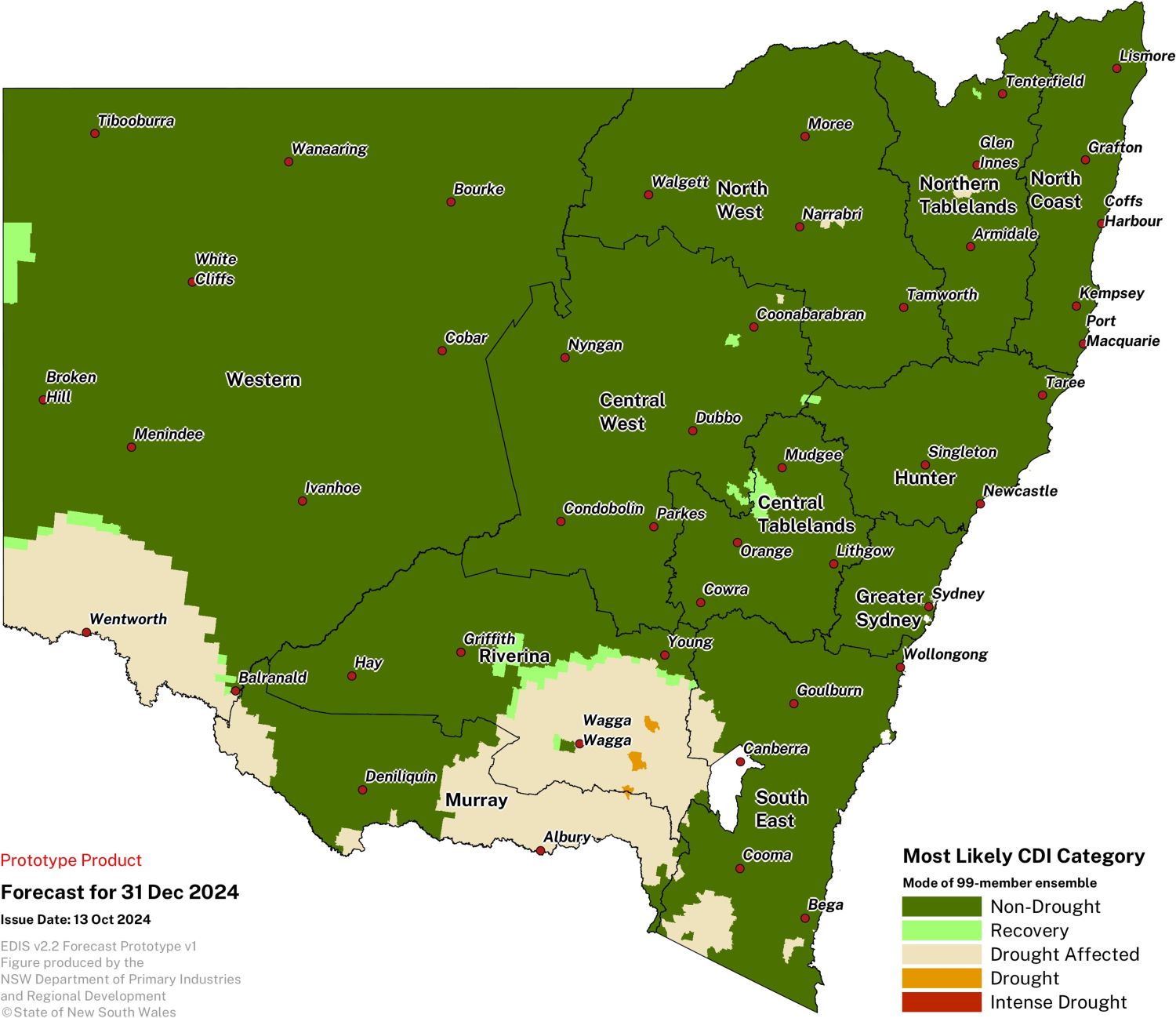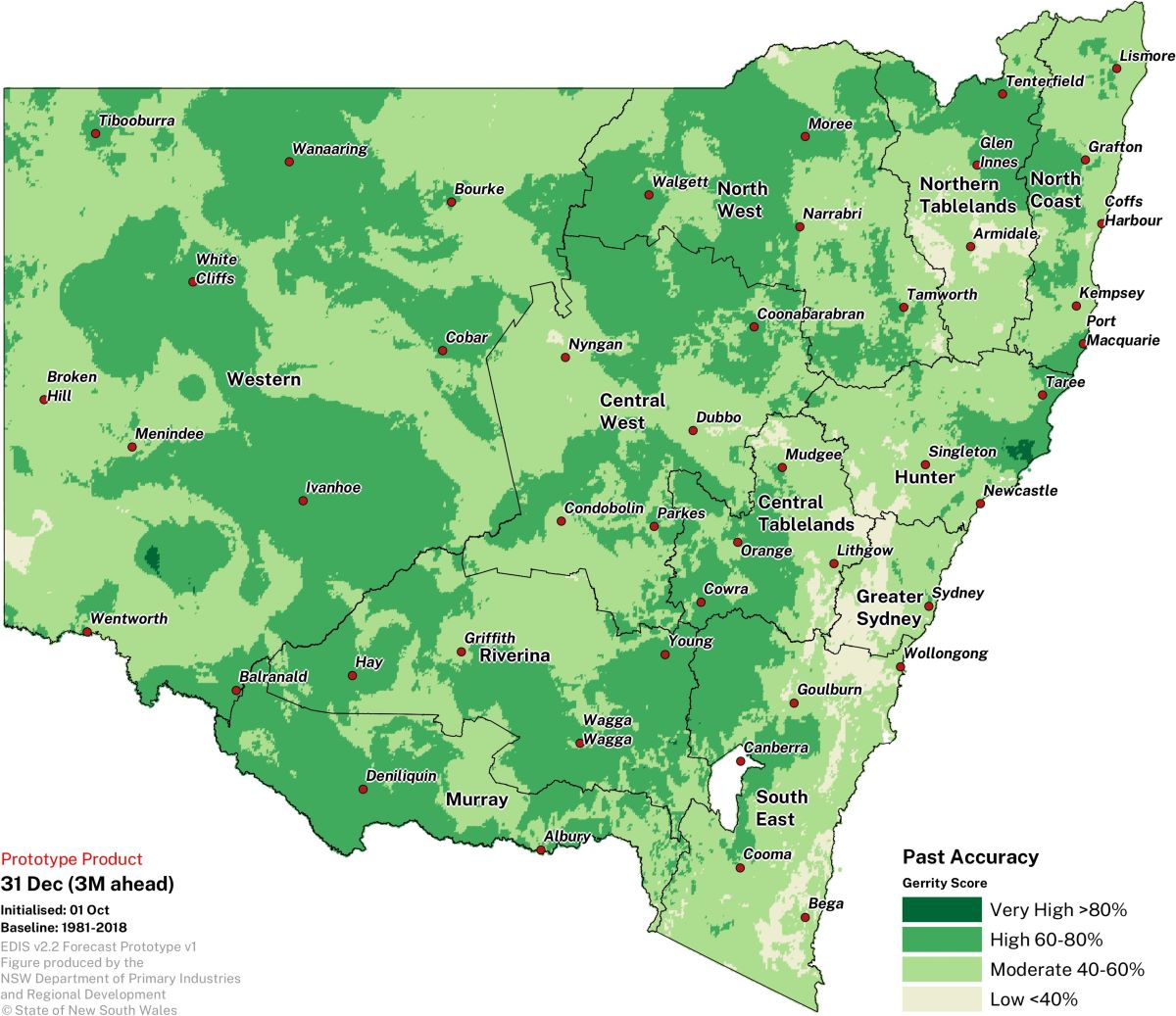October 2025
DPIRD drought forecast
DPIRD’s Drought Forecast (top right) shows the most likely outcome at 31 January 2026.
- The most likely outcome is that large parts of western, southern and central NSW will remain in the Drought Affected category of the NSW-CDI at 31 January 2026.
- Rainfall over the next three months will likely not be enough to lift all the underlying drought indicators above the 30th percentile, the threshold needed to be categorised as being in the NSW-CDI Recovery category.
- For many locations in southern NSW the most likely forecast outcome has the underlying indicators very close to the 30th percentile. For example, at Cootamundra the forecast Plant Growth Index just below the threshold, whereas the Rainfall Index and Soil Water Index are just above 30%.
- For drought affected areas of the Murray and Riverina LLS regions, drought conditions are likely to continue, with most of the region likely to remain in the NSW-CDI Drought Affected category.
- Areas in the Drought category are likely to return to the Drought Affected category at the end of January.
- In the west, some areas may transition back into the Recovery category (e.g., Broken Hill region, south of Menindee, west of White Cliffs) by the end of January 2026.
- In central NSW, the area in the NSW-CDI Drought Affected category will likely expand (e.g., north of Orange and Condobolin).
- Areas in the east, central north and northeast currently in the Non-Drought category are likely to remain in this category by 31 January 2026.
- It is important to check forecasts and observations regularly for updates over the coming season.
Forecast ensemble agreement and historical accuracy vary by region.
- In this forecast period regions of moderate to low agreement and accuracy correspond to those areas that are forecast to transition into the Recovery or Drought Affected category.
- Past skill for this forecast period is moderate to high for most of NSW.
DPIRD’s drought forecast uses the Bureau of Meteorology seasonal climate model ensemble to determine the NSW-CDI for the coming forecast period. The drought forecast figure shows the most frequent (mode) drought category in the 99-member model ensemble at the end of the forecast period.
Forecast releases
Drought Forecast maps are provided twice a month (on the release of the SSU and around the 20th of the month). Check here to see the latest version available. The latest version could be different to the figure below.

Understanding the DPIRD drought forecast figures
Most Likely CDI Category
The DPIRD drought forecast for NSW presents the ‘Most Likely’ Combined Drought Indicator (CDI) category for the forecast period. The Most Likely CDI category is determined by identifying the 'mode' of the CDI. The mode is the category that appears most frequently across all possible forecast outcomes in the ensemble run. It is the most common prediction for drought conditions in the forecast period based on the model's simulations.
This map can be used alongside the most current CDI map to observe current conditions and the most likely conditions in three months’ time.
Ensemble Agreement
Ensemble agreement refers to the level of consensus on the mode among the ensemble members. When there is high agreement, it means that most of models are predicting a similar CDI category, suggesting greater confidence in the forecast. If the agreement is low, it suggests that there is a wide range of possible outcomes, leading to greater uncertainty in the forecast.
Past Skill
Past skill refers to how well the model predicts the correct CDI drought category compared to random climatological chance for every forecast month in the historical record (1981 –2018), allowing an assessment of the reliability of the current forecast. If the model has consistently provided skilful predictions, there is more confidence in its current output. However, if past skill is low, it might suggest a need for more caution in interpreting the forecast, especially when ensemble agreement is low.
Overview of the DPIRD drought forecast
The seasonal drought forecast have been developed as a drought early warning system to prepare for drought events, mitigate drought impacts, and better aid farm and Government management decisions.
The DPIRD drought forecast has been generated by forcing the NSW DPI Enhanced Drought Information System (EDIS) with calibrated forecast variables from the Bureau’s seasonal prediction system, ACCESS-S to produce an ensemble of drought indicators. A 99-member lagged ensemble is used to determine the drought forecast.
A technical description of the DPIRD drought forecast, including a full analysis of the systems skill, is being prepared for public release.
Find out more information about the drought forecast here.
Provide feedback
To provide feedback on the DPIRD Drought forecast, please email seasonal.conditions@dpird.nsw.gov.au
If you want to join our advanced forecast user group and help shape new products register your interest here.
To complete our feedback survey, please click here.